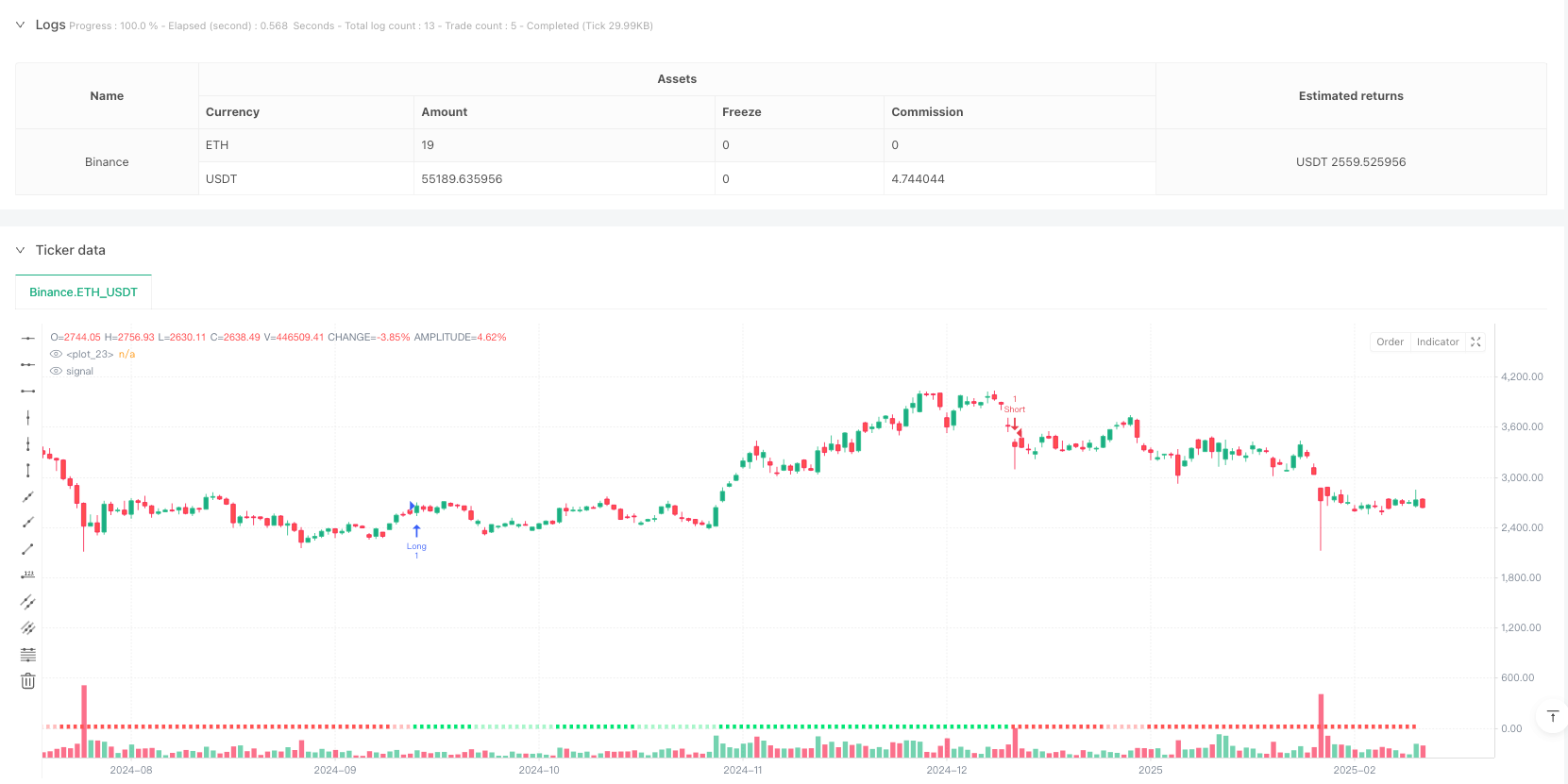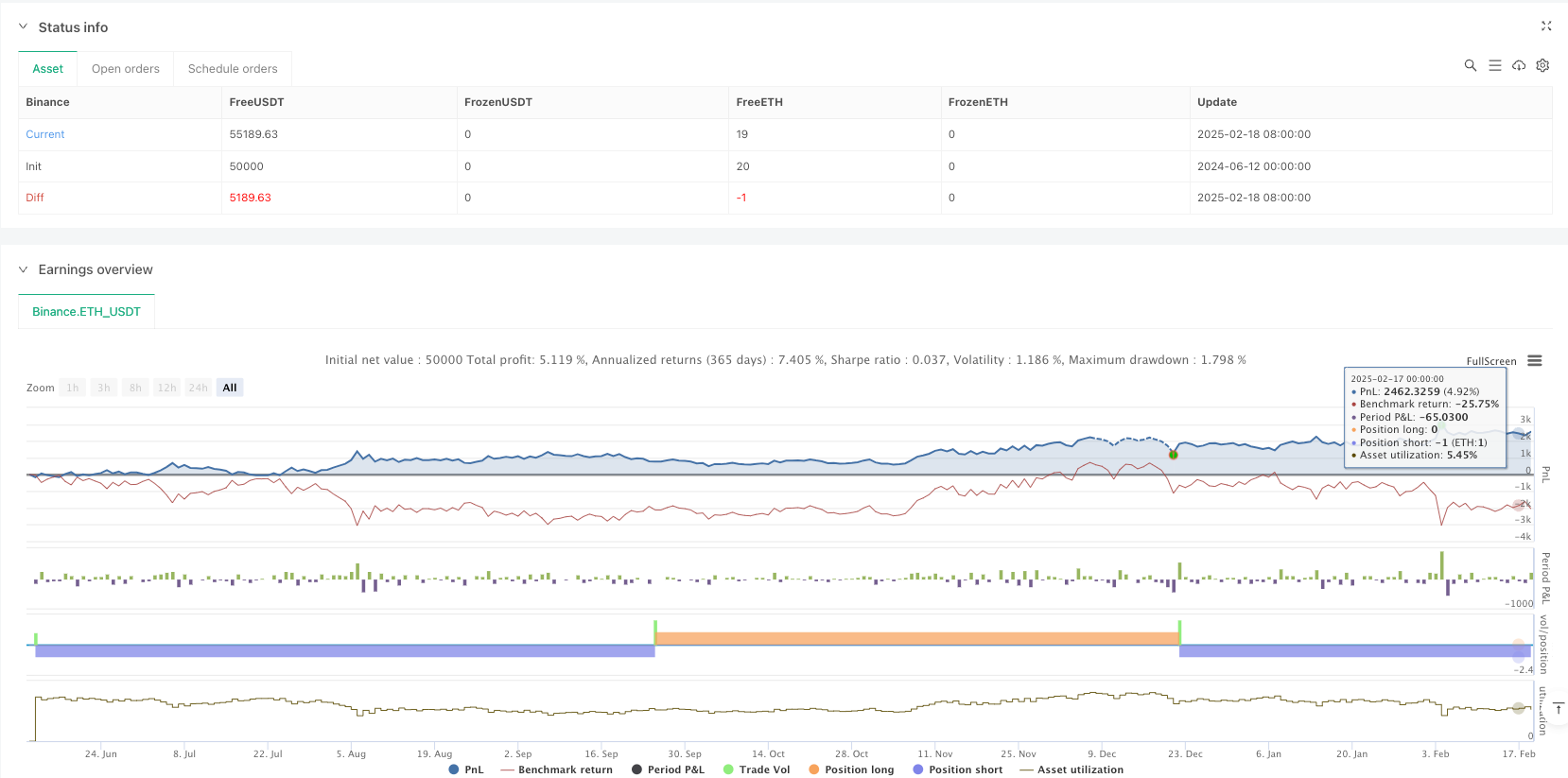

概述
该策略基于多重周期的唐奇安通道指标构建趋势跟踪系统。通过分析不同时间周期的唐奇安通道突破情况,结合主趋势和局部趋势的配合关系,形成视觉直观的趋势带状图形。策略采用颜色深浅变化来展示趋势的强弱程度,绿色系代表上涨趋势,红色系代表下跌趋势,颜色越深表示趋势越明显。
策略原理
策略的核心是基于唐奇安通道(Donchian Channel)指标进行趋势判断。唐奇安通道由最高价通道和最低价通道构成,通过对比当前价格与通道的位置关系来判断趋势。主要包含以下几个关键组成部分: 1. 主趋势判断:利用20周期唐奇安通道,当价格突破上轨形成上涨趋势,突破下轨形成下跌趋势 2. 局部趋势判断:在主趋势框架下,使用较短周期的唐奇安通道判断局部趋势的走向 3. 趋势带状图:通过10个不同周期的唐奇安通道组合形成趋势带,颜色深浅反映趋势强度 4. 交易信号:主趋势向上开多单,主趋势向下开空单,趋势反转时平仓
策略优势
- 趋势判断客观:基于价格突破判断趋势,避免主观判断带来的偏差
- 多重周期确认:通过不同周期趋势的叠加,提高趋势判断的准确性
- 视觉效果直观:趋势带的颜色变化直观显示市场状态
- 交易规则明确:入场和出场信号清晰,便于程序化实现
- 适应性强:可根据交易品种特点调整参数优化策略表现
策略风险
- 趋势反转风险:在趋势转折点可能出现较大回撤
- 震荡市不适用:横盘震荡行情容易产生虚假信号
- 参数敏感性:不同参数设置会显著影响策略效果
- 滑点影响:频繁交易可能受到滑点影响
- 系统性风险:市场突发事件可能导致重大损失
策略优化方向
- 增加趋势强度过滤:引入ADX等趋势强度指标,过滤弱趋势信号
- 优化止损设置:基于ATR动态调整止损位置,提高风险控制能力
- 加入成交量确认:结合成交量分析验证趋势有效性
- 引入波动率适应:根据市场波动率动态调整参数
- 完善仓位管理:基于趋势强度动态调整持仓规模
总结
该策略通过多重周期唐奇安通道的创新应用,构建了一个视觉效果突出、逻辑清晰的趋势跟踪交易系统。策略的核心优势在于将复杂的趋势分析过程可视化,便于交易者直观把握市场走势。通过合理的参数优化和风险控制措施,该策略具有良好的实战应用价值。建议交易者在实盘应用时注意市场环境的选择,并结合自身风险承受能力进行仓位管理。
策略源码
/*backtest
start: 2024-06-12 00:00:00
end: 2025-02-19 08:00:00
period: 1d
basePeriod: 1d
exchanges: [{"eid":"Binance","currency":"ETH_USDT"}]
*/
//@version=6
strategy("Donchian Trend Ribbon Strategy", shorttitle="DonchianTrendRibbonStrat", overlay=true, precision=0)
//~~~~~~~~~~~~~~~~~~~~~~~~~~~~~~~~~~~~~~~~~~~~~~~~~~~~~~~~~~~~~~~~~~~~~~~~~~~~~~
// Parameters
//~~~~~~~~~~~~~~~~~~~~~~~~~~~~~~~~~~~~~~~~~~~~~~~~~~~~~~~~~~~~~~~~~~~~~~~~~~~~~~
dlen = input.int(defval=20, title="Donchian Channel Period", minval=10)
//~~~~~~~~~~~~~~~~~~~~~~~~~~~~~~~~~~~~~~~~~~~~~~~~~~~~~~~~~~~~~~~~~~~~~~~~~~~~~~
// Helper function to determine color
//~~~~~~~~~~~~~~~~~~~~~~~~~~~~~~~~~~~~~~~~~~~~~~~~~~~~~~~~~~~~~~~~~~~~~~~~~~~~~~
f_color(mainTrend, localTrend) =>
// mainTrend = 1 => uptrend, -1 => downtrend
// localTrend = 1 => local uptrend, -1 => local downtrend
// Return color based on whether local trend aligns with the main trend
color c = na
if mainTrend == 1
c := localTrend == 1 ? color.new(color.lime, 0) : color.new(color.lime, 60)
else if mainTrend == -1
c := localTrend == -1 ? color.new(color.red, 0) : color.new(color.red, 60)
else
c := na
c
//~~~~~~~~~~~~~~~~~~~~~~~~~~~~~~~~~~~~~~~~~~~~~~~~~~~~~~~~~~~~~~~~~~~~~~~~~~~~~~
// Function dchannel - determines main trend (1 or -1)
//~~~~~~~~~~~~~~~~~~~~~~~~~~~~~~~~~~~~~~~~~~~~~~~~~~~~~~~~~~~~~~~~~~~~~~~~~~~~~~
dchannel(len) =>
float hh = ta.highest(len)
float ll = ta.lowest(len)
var int tr = 0
tr := close > hh[1] ? 1 : close < ll[1] ? -1 : nz(tr[1])
//~~~~~~~~~~~~~~~~~~~~~~~~~~~~~~~~~~~~~~~~~~~~~~~~~~~~~~~~~~~~~~~~~~~~~~~~~~~~~~
// Function dchannelalt - determines local trend and returns color
//~~~~~~~~~~~~~~~~~~~~~~~~~~~~~~~~~~~~~~~~~~~~~~~~~~~~~~~~~~~~~~~~~~~~~~~~~~~~~~
dchannelalt(len, maintrend) =>
float hh = ta.highest(len)
float ll = ta.lowest(len)
var int tr = 0
tr := close > hh[1] ? 1 : close < ll[1] ? -1 : nz(tr[1])
f_color(maintrend, tr)
//~~~~~~~~~~~~~~~~~~~~~~~~~~~~~~~~~~~~~~~~~~~~~~~~~~~~~~~~~~~~~~~~~~~~~~~~~~~~~~
// Calculate main trend
//~~~~~~~~~~~~~~~~~~~~~~~~~~~~~~~~~~~~~~~~~~~~~~~~~~~~~~~~~~~~~~~~~~~~~~~~~~~~~~
maintrend = dchannel(dlen)
//~~~~~~~~~~~~~~~~~~~~~~~~~~~~~~~~~~~~~~~~~~~~~~~~~~~~~~~~~~~~~~~~~~~~~~~~~~~~~~
// Plotting the Donchian Trend Ribbon
//~~~~~~~~~~~~~~~~~~~~~~~~~~~~~~~~~~~~~~~~~~~~~~~~~~~~~~~~~~~~~~~~~~~~~~~~~~~~~~
plot( 5, color=dchannelalt(dlen - 0, maintrend), style=plot.style_columns, histbase= 0)
plot(10, color=dchannelalt(dlen - 1, maintrend), style=plot.style_columns, histbase= 5)
plot(15, color=dchannelalt(dlen - 2, maintrend), style=plot.style_columns, histbase=10)
plot(20, color=dchannelalt(dlen - 3, maintrend), style=plot.style_columns, histbase=15)
plot(25, color=dchannelalt(dlen - 4, maintrend), style=plot.style_columns, histbase=20)
plot(30, color=dchannelalt(dlen - 5, maintrend), style=plot.style_columns, histbase=25)
plot(35, color=dchannelalt(dlen - 6, maintrend), style=plot.style_columns, histbase=30)
plot(40, color=dchannelalt(dlen - 7, maintrend), style=plot.style_columns, histbase=35)
plot(45, color=dchannelalt(dlen - 8, maintrend), style=plot.style_columns, histbase=40)
plot(50, color=dchannelalt(dlen - 9, maintrend), style=plot.style_columns, histbase=45)
//~~~~~~~~~~~~~~~~~~~~~~~~~~~~~~~~~~~~~~~~~~~~~~~~~~~~~~~~~~~~~~~~~~~~~~~~~~~~~~
// Trading Logic (STRATEGY)
//~~~~~~~~~~~~~~~~~~~~~~~~~~~~~~~~~~~~~~~~~~~~~~~~~~~~~~~~~~~~~~~~~~~~~~~~~~~~~~
bool goLong = (maintrend == 1)
bool goShort = (maintrend == -1)
// Entry signals
if goLong
strategy.entry("Long", strategy.long)
if goShort
strategy.entry("Short", strategy.short)
// Close positions when trend changes
if strategy.position_size > 0 and goShort
strategy.close("Long")
if strategy.position_size < 0 and goLong
strategy.close("Short")
相关推荐